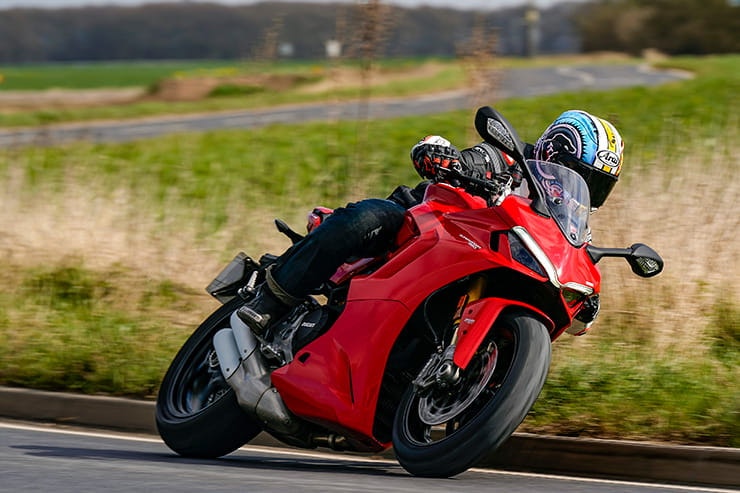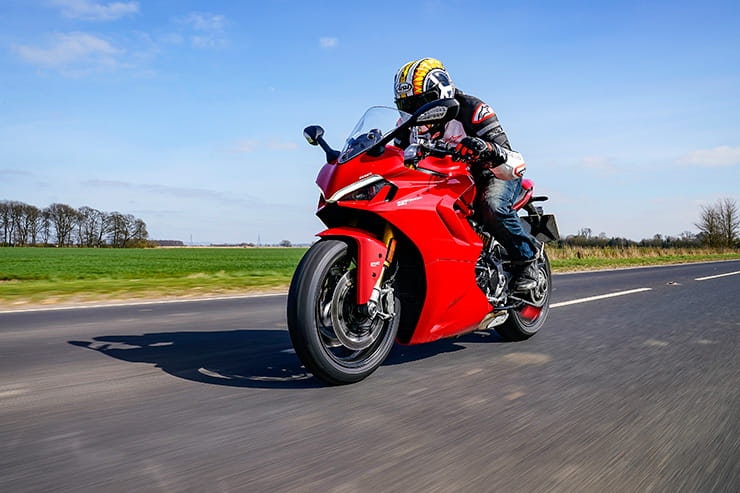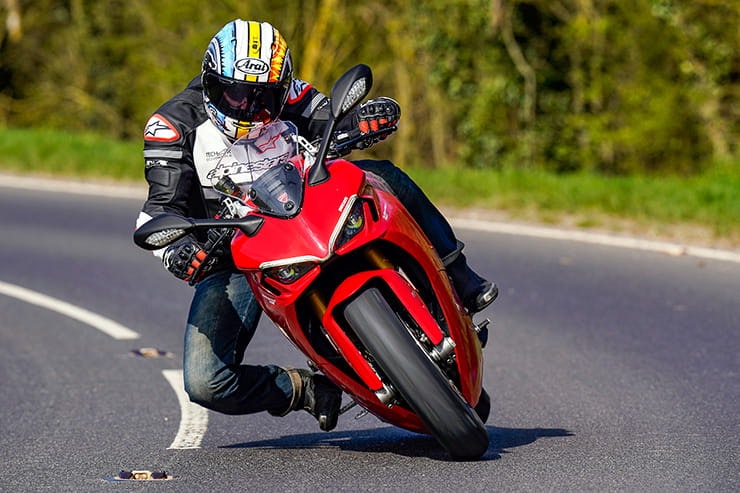Ducati SuperSport 950 S (2021) - Review
BikeSocial Road Tester
24.03.2021
Overview
Back in 2017, Ducati launched the SuperSport 950, utilising the same 937cc Testastretta L-twin engine that can be found powering other models in Ducati’s range. The SuperSport offered a sensible, softer alternative to those who loved Ducati styling, who possibly wanted a Panigale but rationally sought something more real-world: an attractive road bike that wasn’t going to break the bank balance but was still capable, even on the track.
For 2021 Ducati has stayed with a proven recipe; think of the SuperSport as a practical sports bike capable of touring and commuting that can also take on the track with knee dragging action, while making you feel special every time you open the garage door. Aside from now making the SuperSport Euro-5 compliant without losing any engine performance, the stylish Italians have added even more flair, and improved its design and stance. As well as making the SuperSport more desirable than ever, they’ve also upped the electronic aids with a new 6-axis IMU, which results in more advanced and sophisticated rider aids that are now lean-sensitive.
We spent a week and around 750 miles in varying conditions, putting the road-focused SuperSport through its paces. So, is this the Ducati road riders should actually buy?
Unintimidating engine
Easy handling
Improved looks, comfort and tech
Mirrors still vibrate (not as badly as before)
Trapped fingers on full lock
Tank range for serious touring
Ducati SuperSport 950 S (2021) Price
We have on test the SuperSport 950 S, at £13,895, opposed to the standard model’s £12,295. The key difference between the standard and the S version is the suspension, which is now decked out with fully adjustable Öhlins units on the S with larger-diameter 48mm forks rather than fully adjustable Marzocchi 43mm forks, with a fully adjustable Sachs on the rear suspending the standard model. Brakes, weight and engine performance are the same as the outgoing model so you’re essentially paying £1600 for the suspension, oh, and the single-seat cover. The S is also available in white and, for some reason, you get red stripes on the wheels, which I’m not a fan of. Now I’ve pointed them out, you won’t stop looking at that odd red stripe, sorry.
As you’d expect, prices have notched up a fraction from the previous model, but still the SuperSport isn’t smashing the bank, especially in today’s market, where big adventure bikes and sports bikes are close to £20,000. For comparison, a standard V2 Panigale is now £14,995, and the V4 £19,995.
If I were to be critical and tight (which I am), £1600 for Öhlins suspension is a little steep, despite the quality. But there is no argument, the gold Öhlins units do add a cherry to the icing on a perfectly formed cake. The new looks, with those obvious shark gills, are more Panigale than ever and along with new LED headlights make the SuperSport more desirable than ever. As an everyday sports bike or sports tourer there is, arguably, competition from Kawasaki with the Ninja 1000SX and from Suzuki with the GSX-S1000F, but neither gets close in terms of looks or appeal. I guess the nearest competition could be from Aprilia with their new RS660, which is cheaper at £10,149 but down on power and, in my view, not as desirable as the Ducati. The new SuperSport is the type of bike that will make you smile every time you open the garage door.
Power and torque
The L-twin Desmodromic engine is now Euro-5 compliant, and Ducati claims they haven’t mislaid any power of torque in the process. Peak power is 108bhp @ 9000rpm, with peak torque at 69lbft @ 6500rpm (there will also be a 35kw version available for A2 licence holders). Ducati revised the exhaust and fuelling to ensure the new 2021 model achieved Euro-5 standard, which wasn’t the hardest job in the world as the engine is shared with the Hypermotard 950 and Multistrada 950, models that are already Euro-5 compliant.
The 950 L-twin has been designed to attract younger, less experienced riders who may be intimidated by the Panigale both in terms of performance and price. The engine is usable, producing 80% of its torque at only 3500rpm. Service intervals remain wide at every 15,000km (or every year, of course).
Engine, gearbox and exhaust
There is a lovely burble on the overrun, even at low rpm, which pops with character as you roll to a stop. Around town it’s noticeable, but not annoying, simply adding a little charm. Higher in the rpm, it’s addictive and gives the bike a sporty feel. It sounds soulful for a standard bike, especially one which is Euro-5 compliant. It’s hard not to like.
It has been a while since I’ve ridden a sporty Ducati twin and I quickly remembered why they make so much sense as a road bike. There is a lovely drive from low down in the revs, accompanied by a snarl and deep breath from the airbox. I’m old enough to remember the original Ducati 916, and my first exciting ride on a 996 and 998. The user-friendly SuperSport makes similar power to the 916 – which makes you think, this is not a slow bike.
Initially I thought the Duke was a little soft – dare I say, lazy – especially when compared to modern sports bike that want to prevent you from breathing in. But the more clicked-in to the L-twin power I became, the more I enjoyed it. You don’t need to be bouncing off the rev limiter, you don’t need to jump up and down the (standard) up-and-down quick-shifter… instead, there is that lovely spread of torque that allows you to play with just fourth and fifth gear between 60 and 100mph. That grunt starts to tail off after 8000rpm and power starts to drop after 9000rpm, but 4500-8000rpm is the happy zone that’s perfect for a fast and fluid road ride.
I can see why some may prefer the SuperSport to one of Ducati’s pricier, more focused sporting siblings, especially for the road. You can use the engine, enjoy the sound and feel, drive out of corners, and feel in control. You are the boss. There are multiple rider modes (I’ll explain later), and now lean-sensitive traction control and wheelie control, but arguably they are not needed once you’re up to speed. Sure the 950 will happily lift the front wheel in the first few gears (with the TC disabled), but this is not a bike you have to fight. You’re not clambering over the front to keep the front end down or relying heavily on the electronics to keep you safe like you might on a Panigale V4. And, better still, you’re not doubling the national speed limit with every handful of throttle. Yes, it’s quick – 996 quick, if you are old enough to remember – but not scary quick.
At low speeds the fuelling is excellent. Ducati has perfected L-twin fuel injection, the only disappointment being the now standard quick-shifter. Above 30mph and higher in the revs it works perfectly, but at low rpm it can be snatchy and doesn’t balance perfectly with the revs. It wasn’t consistent either. Sometimes it would work perfectly and sometimes not. Ducati’s quick-shifter system on other models, like the new Multistrada, is perfect, but this isn’t. An eight out of 10, maybe, but not perfect like I’ve come to expect from Ducati.
While I’m grumbling, I don’t like the way the bars now trap fingers and thumbs on the new bodywork on full lock. This is only noticeable when during slow speed U-turns, usually when one or both feet are down. It’s not dangerous or too dramatic, but annoying and again something I wasn’t expecting from Ducati.
Ducati SuperSport 950 S (2021) Comfort and economy
There are two trains of thought here. One, the SuperSport is comfortable (the seat has increased in comfort) with relatively high bars and low pegs that not too far back. When I first threw a leg over the surprisingly low seat (810mm, with optional seats offering plus 25mm and minus 20mm) I was actually surprised by the relatively roomy ergonomics. The screen is adjustable by 50mm, the new TFT clock is neat and clear, and the visual appeal once onboard is high. The way the bodywork swoops under the clocks, the neat actuation of the buttons, the relatively easy to navigate clocks… it all adds up to a sophisticated cockpit.
My first ride on the SuperSport was a 120-mile stint of just under two hours. With the screen fully upright, wind protection wasn’t too bad while the seat and ergonomics were faultless. But again, little niggles started to creep in. The mirrors give an excellent view behind but once the revs build and vibrations start, the images become blurred. The mirrors have improved over the previous model but they’re not perfect and at high speed it’s hard to see if the car following has a roof rack or blue lights on the roof – you understand my issue. The screen is adequate but I think taller riders may prefer something larger, and is the fuel range long enough with a 16-litre fuel tank? The fuel light came on at around the 130-mile mark, with around 40 miles remaining, depending on conditions. I averaged 47.5mpg, which gives a theoretical range of 167 miles. Is that enough?
Ducati has improved comfort, and I rode all day without any physical complaints on that comfortable seat while the bodywork deflected the heat generated by the engine away from my legs. You could easily embark on some serious touring on this comfier 950; there are even optional panniers in the accessories catalogue. But doubts remain about the tank range and those mirrors will start to annoy.
As mentioned, there are two trains of thought here. The alternative point of view – comparing the comfort of the SuperSport to a dedicated track bike – is like comparing a sofa to a wooden park bench. Looked at this way, the tank range is easily large enough for two hours in the saddle, especially as those inexperienced, relatively new riders the 950 is aimed at won’t want to go much further anyway.
Handling, suspension and weight
The improved comfort and relaxed riding position haven’t dampened the sporting abilities of the Ducati, but you have to flick into a slightly different mind-set and style of riding to unlock them. The Öhlins suspension is sublime, there is a superb, natural feel from both ends. It copes with everything from fast-flowing stuff to bumpy B-roads taken at speed. I really pushed and asked some difficult questions of the 950’s stability and handling, but the Duke always came back with the correct answers.
The taller riding position will feel more natural for most riders. At 184kg, this is not a heavy bike and you can point and roll into corners with knee-down levels of lean with relative ease. The suspension is on the sporty side of sports touring and holds the chassis once on its side, yet is soft enough to take the strain on the exit, allowing you to dial in the L-twin power early in and feel for the grip. Alternatively, simply rely on the very clever electronics, which are now lean-sensitive due to the new Bosch 6-axis IMU.
On track with tack-focused rubber an experienced rider will have to have to reduce the suspension’s movement because, in standard trim, the Öhlins set up is a little too soft for serious track action. But for most, especially the target audience, the base set up will work on the road and track, especially if you stay with the standard Pirelli Rosso 3 rubber. It’s easy on track, and far more forgiving than its sporting siblings from Bologna.
Ducati SuperSport 950 S (2021) Brakes
The Brembo radial brakes remain as the old model’s, which isn’t a bad thing as they are top quality and more than strong enough for the road and track. Equally, they are not too harsh, there is a nice feel from the lever, perfect for inexperienced riders or those pushing the limits on the track, when you want to brake deep into the turn while feeling for grip.
The big change for 2021 is the introduction of a 6-axis IMU, which means the ABS braking can now be lean-sensitive. There are three levels to choose from: Sports mode is level 2, ‘road and track’, and Touring and Urban are level 3, ‘safe and stable’. Option 1 is front wheel only, conventional ABS, not cornering ABS, which allows you to slide the rear on corner entry. Should you want to, obviously…
Rider aids, extra equipment and accessories
This is where Ducati has made significant gains over its predecessor. For 2021 the Bologna factory has fitted the new SuperSport with a Bosch 6-axis IMU, which measures roll, pitch, and yaw. This means the bike knows what is happing, how it is moving. The IMU is linked to the ‘EVO’ rider aids, Bosch cornering ABS, Ducati Traction Control (DTC), Ducati Wheelie Control (DWC), and even the Ducati Quickshift up/down (DQS). The parameters of these rider aids are linked to the three rider modes, Sport, Touring and Urban. The traction control is set from 1-8 or off, Sports mode is 3, Touring 4, and Urban 6. Wheelie control is out of 1-4 and off, Sport set to 2, Touring 3, and Urban 4.
Aside from pre-setting the rider aids, each mode has a specific power character set by the ride by wire. Sport has full power, sporty setup, Touring full power and a ‘road’ throttle, and Urban 75bhp and a safe/soft set up. You can play around with the modes and customise your own settings. For example, I had Sport set as full power, with no rider aids with ABS set to 1. Alternatively, you could opt for full power in Urban mode, and increase the rider aids further.
As we’ve come to expect from Ducati, the rider aids are excellent, and a big step over the previous model as well as perfect for both new and inexperienced riders. The cornering ABS and TC are like riding with an expert on your shoulder, keeping you safe and preventing you from doing something untoward. The new 4.3-inch full colour dash makes the settings clear and easy to customise, for a track day for example. Should you want to go on track there is also an optional full racing exhaust (£2150) which adds 2% more power 9% more torque and reduces weight by 4.6kg. Not all accessories are performance related. The integrated hard luggage looks stylish and there are also optional screens and heated grips, which can be purchased as a touring package with the panniers for £1221.
Rivals
Ducati SuperSport 950 S (2021) Verdict
Ducati is on top form and rolling out one great bike after another, and the SuperSport 950 follows that trend. Ducati has increased its desirability: it’s now a stunning bike, with a functional design that features new LED DRL lights and clever bodywork that takes engine heat away from the rider. The electronics are a welcome and significant upgrade, which can be easily personalised. Now Euro-5 complaint, without losing any performance, the engine/exhaust still delivers fun, character, and real-world performance, which isn’t intimidating.
Surprisingly, I’ve uncovered a few niggles. The mirrors vibrate too much at high rpm/speed, and, with comfort improved, I’d like a longer fuel range so I could embark on some serious miles. Also, the bars trap fingers on full lock, and the quick-shifter isn’t perfect at low speeds – not what we’d expect from Ducati.
There is no doubt, however, that the SuperSport is a great bike. It’s also arguable that the target audience may not want a larger fuel tank, and for just over 12k for the standard model, I’m probably being harsh comparing the fluidity of the quick-shifter compared to pricier models in Ducati’s range. But for me the 950 is a good bike, a nine out of 10, just not 10 out of 10, which is what at I’ve come to expect from Ducati of late.
Ducati SuperSport 950 S (2021) Technical Specification
Photography: Tim Keeton, Impact Images
What is MCIA Secured?
MCIA Secured gives bike buyers the chance to see just how much work a manufacturer has put into making their new investment as resistant to theft as possible.
As we all know, the more security you use, the less chance there is of your bike being stolen. In fact, based on research by Bennetts, using a disc lock makes your machine three times less likely to be stolen, while heavy duty kit can make it less likely to be stolen than a car. For reviews of the best security products, click here.
MCIA Secured gives motorcycles a rating out of five stars, based on the following being fitted to a new bike as standard:
A steering lock that meets the UNECE 62 standard
An ignition immobiliser system
A vehicle marking system
An alarm system
A vehicle tracking system with subscription
The higher the star rating, the better the security, so always ask your dealer what rating your bike has, and compare it to other machines on your shortlist.


